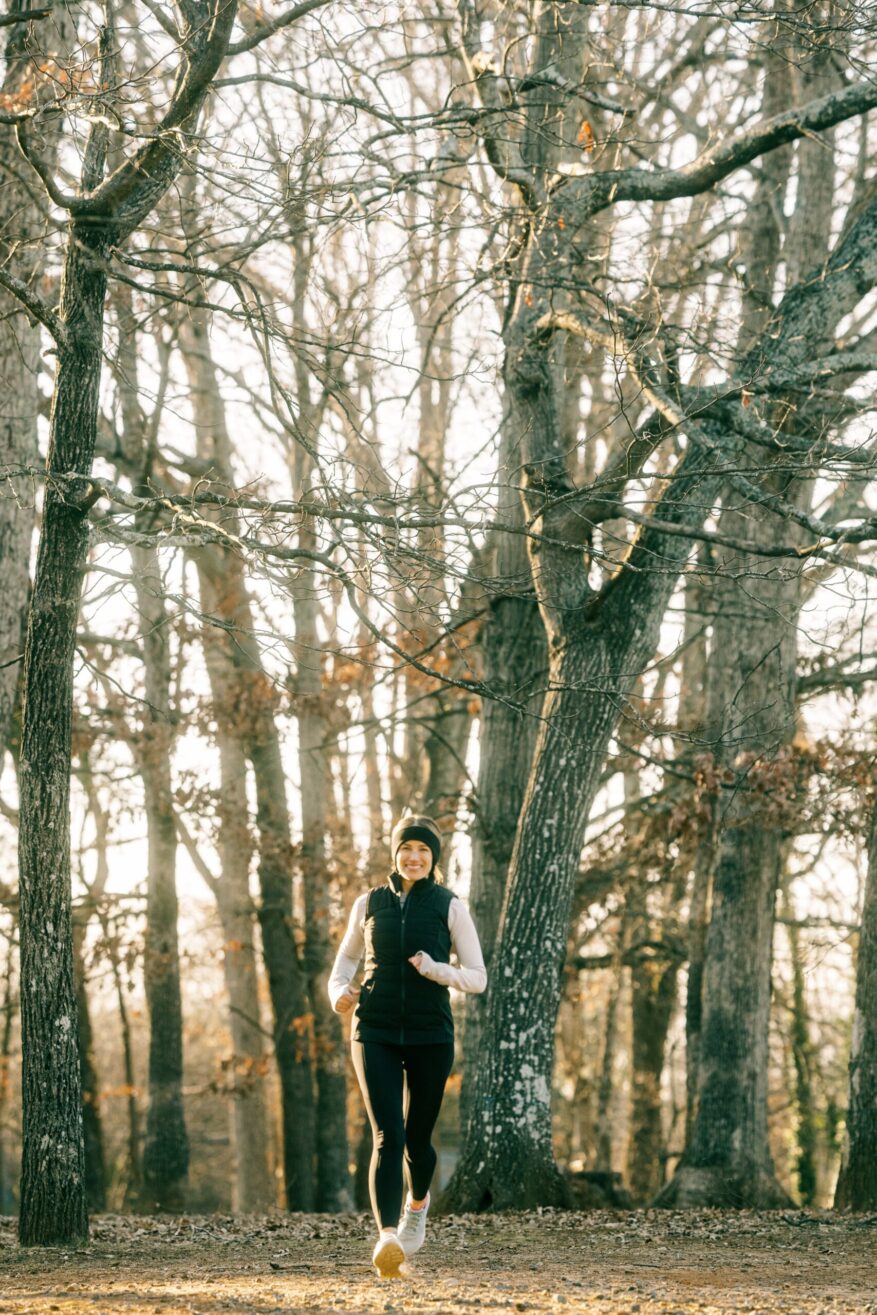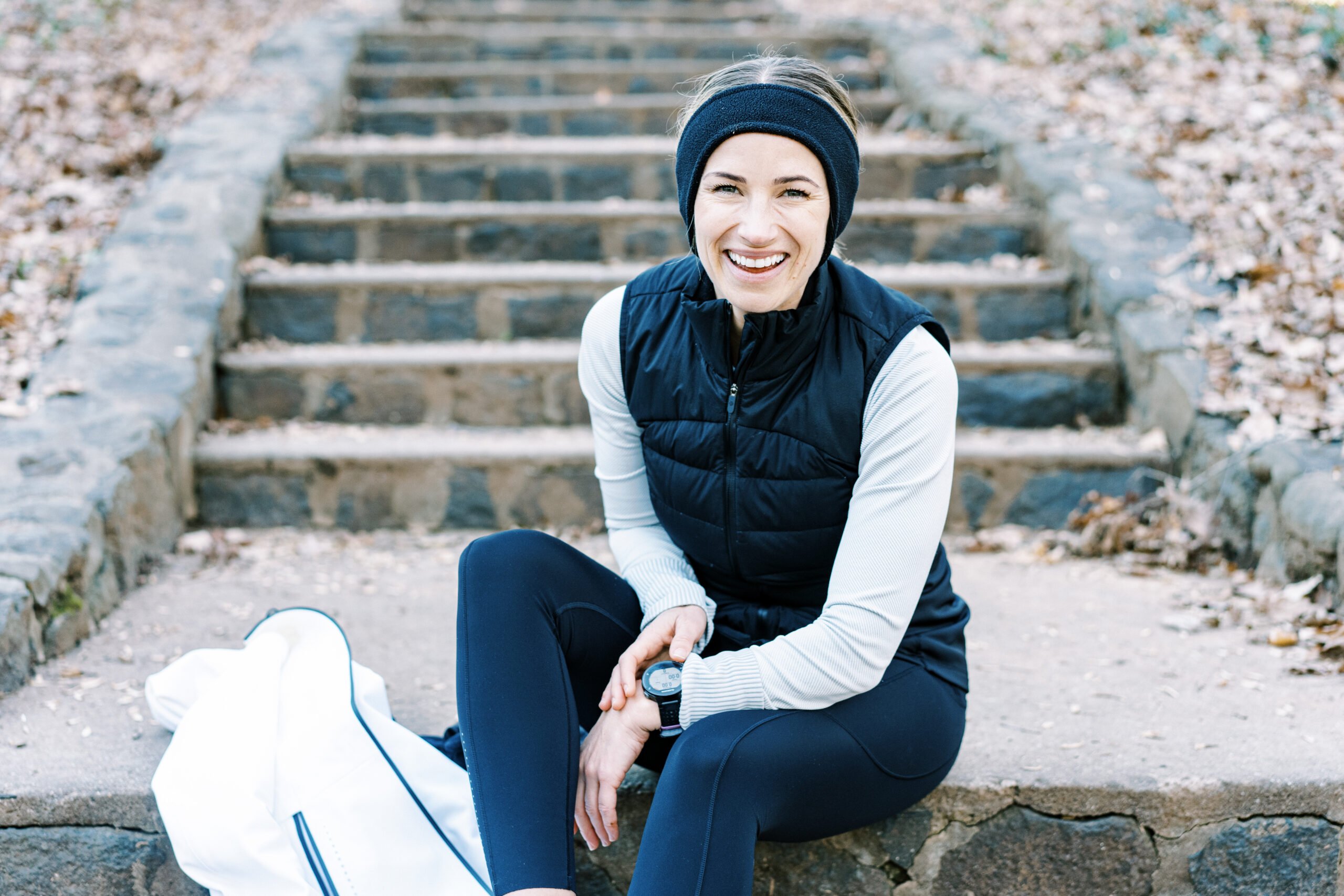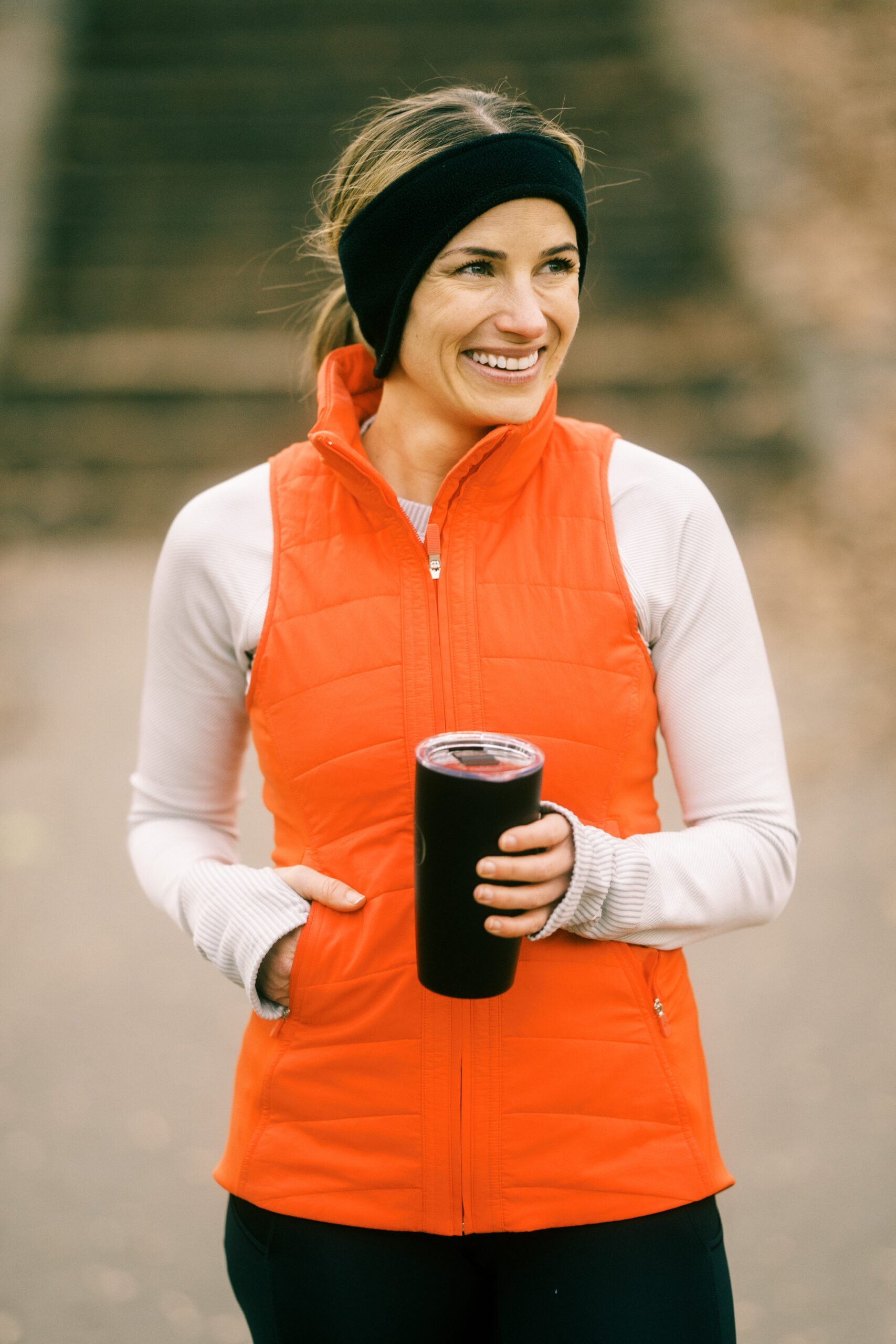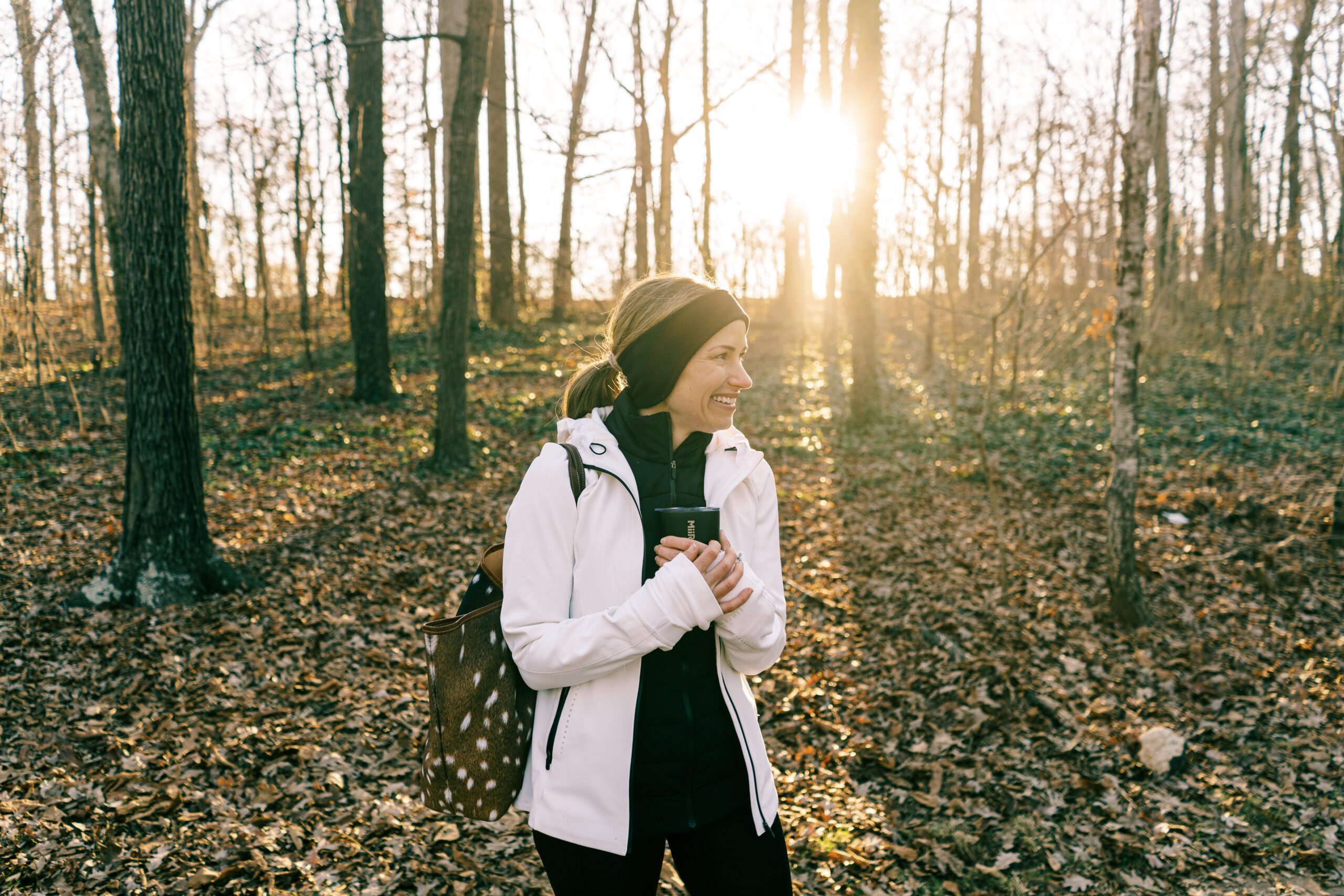The following content may contain affiliate links. When you click and shop the links, we receive a commission.
When you’re a new runner and wondering what to wear running, it’s more straightforward. But when you’re wondering what to wear running in the cold, it’s a little trickier. And cold weather can derail your training if you’re not prepared.
I actually really love running in cold weather. The air is so refreshing, and I think it helps de-puff my eyes when I don’t sleep well. But I used to overdress for almost every run, and after a few years of trial and error, I figured out a pretty good routine for cold-weather runs. While it’s sometimes hard to get out the door, I love it once I do. (And I much prefer winter running over running in the heat.)
Dressing the right way will make or break your run, and when you’re mixing freezing temps with sweat, you have to be careful. I’ve been running for over 20 years, and I’ve raced in some pretty tricky conditions (like the 2018 Boston Marathon).
Today I’m sharing what exactly I wear for running in the cold. (If you need help picking shoes, you can see my favorite running shoes here. And I rounded up my favorite supportive sports bras here.)

What to wear running in the cold
I don’t have to deal with snow very often in North Carolina, but it does get very cold at times. When I lived in Utah, I had to be more careful about running in the snow, but at least I didn’t have to contend with the humid cold like we get in the South. But cold is cold is cold! And it’s important to dress appropriately for it so you enjoy your runs more (and stay safe!)
Below are the general guidelines I use when getting dressed for cold-weather runs. Some factors will change what I decide to wear on cold days, including rain, wind chill, “feels like” temperatures, the type of run I’m doing, and just how I’m feeling (some days I like to be warmer than others!). The right gear makes ALL the difference! I linked my favorite brands for cold weather running clothes below in each section to make shopping easier.
Types of layers:
Base layers are typically thinner and fit close to the body to help keep in warmth. For cold runs, I wear a long sleeve like this Rest Less Pullover Top from Lululemon. When it starts to warm up, I’ll wear a short sleeve shirt or tank with a layer on top (usually the same top as above, the Rest Less Pullover), and then I’ll have the option to shed a layer.
A mid-weight layer is usually a thicker, looser material that can be layered more easily and often has weather-proofing materials (e.g., water resistance). A 1/2 zip is a good mid-layer. I love the Dash 1/2 zip from Brooks.
A running jacket or vest doesn’t necessarily have to be heavy to be warm (this lightweight Patagonia option is amazing), and a zipper (or even a half-zip) is nice since it’s easier to get on over two layers and unzip if you get a little too warm. My very favorite cold weather layer is the Down For It All vest from Lululemon, and if it’s really cold, I love the Lululemon Cross Chill Jacket.
When I’m on the fence, I always take running gloves (pro tip: get a bright-colored pair like the Fast and Free Fleece Running Gloves from Lululemon so you don’t lose them) and an ear band since they’re easy to take off and carry if I get too hot. I need a new one and I’m considering the Fast and Free Fleece Running Ear Warmer from Lululemon.
When you’re buying running clothes, it’s especially important to make sure the materials are moisture-wicking.
Do not wear cotton! Athletic apparel made with technical fabrics is worth the additional cost over an old t-shirt because it is made to wick away sweat from your body which helps you stay warm. And if your clothes aren’t breathable, your body heat will rise, and the heat will have nowhere to go. The worst thing you can do is run in the cold in very damp clothes! Think about it – would you want to go outside in a wet shirt when it’s 20 degrees? No way! So make sure you buy gear that’s sweat-wicking. Brands make this really clear since it’s such a selling point for runners. You can find all of my favorite sports bras for runners here on the blog, since your sports bra wicks sweat that keeps you warm and dry.
Okay, here’s what I wear for each temperature. Keep in mind that humidity and the wind will change what a temperature actually feels like, and a lot of this is a matter of personal preference. It may take some trial and error. If you’re always hot on a run, a good rule of thumb is to remove a layer before you go out. If you’re usually cold, add a layer and definitely take gloves and an earband! Just keep your body temperature at the forefront of your mind when you get dressed.
What to wear running in 40 degrees
- Long-sleeved running shirt – You could get away with short sleeves here, but those first few miles will feel COLD. I love the Swiftly Long Sleeve tee.
If you want inspiration for what to wear in 40 degrees (when not running), read this post.
What to wear running in 30 degrees

Items to wear running in 20 degrees
Shop my Lululemon Cross Chill Jacket here
What to wear running in 10 degrees
- Fleece lined tights – Lululemon’s Fast and Free style also comes in a fleece-lined version, which is my #1 choice for a fleece lined legging.
- Long-sleeved base layer – I still wear the Swiftly Long Sleeve since it’s thin enough to add more layers on top.
A few tips for running in cold weather
Keep your core warm
Some people prefer to be colder on their legs vs. their upper body. I’d much rather have cold legs than a cold torso or arms, so I factor that in with my winter running outfit. Figure out what works best for you and adjust accordingly. However, a good rule of thumb is to make sure your core is dressed a bit warmer than your legs since that will help keep the rest of you warm.
Wear a vest
These Lululemon running vests are super helpful at keeping your core warm without making you feel restricted in a jacket or causing you to overheat. If you don’t have a vest, try layering a tank top under your base layer. It helps to have that extra layer on your core! I love it so much I got a similar one in another color.

Prioritize extremities
Protect your head, ears, fingers and toes!!
A lot of heat is lost through your head, so when in doubt, wear a beanie. You can always remove it. If it’s not too cold, you could wear an ear band instead to keep just your ears warm.
I rarely get cold toes. I do wear slightly thicker socks in the winter, but I don’t buy anything special. But I know some people do get VERY cold toes so they buy extra thick socks for the winter or layer two pairs. I recommend merino wool socks if your toes are always cold. BTW, make sure you’re wearing true running socks since they help prevent blisters!
However, my fingers do get VERY cold, so cold that it makes me nervous at times! So I always take extra caution make sure they’re warm enough. Sometimes I even wear thick Gore Tex ski gloves over my thin running gloves or put hand warmers in my mittens.
Deal with ice – safely
Some people will use traction cleats, spikes or ice grips on the bottom of their shoes. YakTrax is a popular brand. I’ve personally never tried them, but I know many people love them. They just attach to the bottom of your running shoe so if you have a lot of icy days (or snow that gets compacted and becomes icy), you may want to consider this. We don’t deal with too many icy days in North Carolina, thankfully!
If you’re driving to a run on a treadmill because it’s too icy to run outside, again, please prioritize safety over getting in the miles!
A quick note about specific conditions (wind, rain, darkness):
- If it’s raining, I wear a brimmed hat and a rain jacket. And if it’s an extra cold rain, sometimes I wear a fleece earband over the hat, which is extra sexy. I actually love running in the rain!
- If it’s windy, sometimes I’ll layer that rain jacket on top of whatever else I’m wearing; it adds a little warmth and it really helps cut the wind. Sometimes I’ll go for a windbreaker jacket or something wind resistant.
- If it’s dark or dusk, I always wear my light-up reflective vest. I’ve tried many over the 20+ years I’ve been running and this Tracer 360 vest provides the most visibility and is the most comfortable.
Below are some great options for the different layers you’ll need for cold-weather running. I linked my favorite running gear underneath the scrolling images, where available. The great thing about nice gear is that it lasts forever. The bad thing is that I can’t always find the exact one online for you (like that turtleneck I’m wearing in the above picture, which is from Lululemon a few years ago).
Leggings + Capris
My personal favorite winter running leggings are the Lululemon Fast & Free leggings but if it’s colder than 15 degrees, I usually need something warmer! Which leads me to fleece-lined running leggings …
Fleece Lined Running Tights / Thermal Options
I’ve also been known to layer looser running pants over leggings!
Long Sleeve Shirts (Base Layers)
Vests & Jackets
Accessories (gloves, mittens, earbands, beanie, reflective gear)
What’s your approach to dressing for cold weather runs?
SHOP THE POST
terilynadams.com (Article Sourced Website)
#wear #running #cold #outfits #gear #temperature


